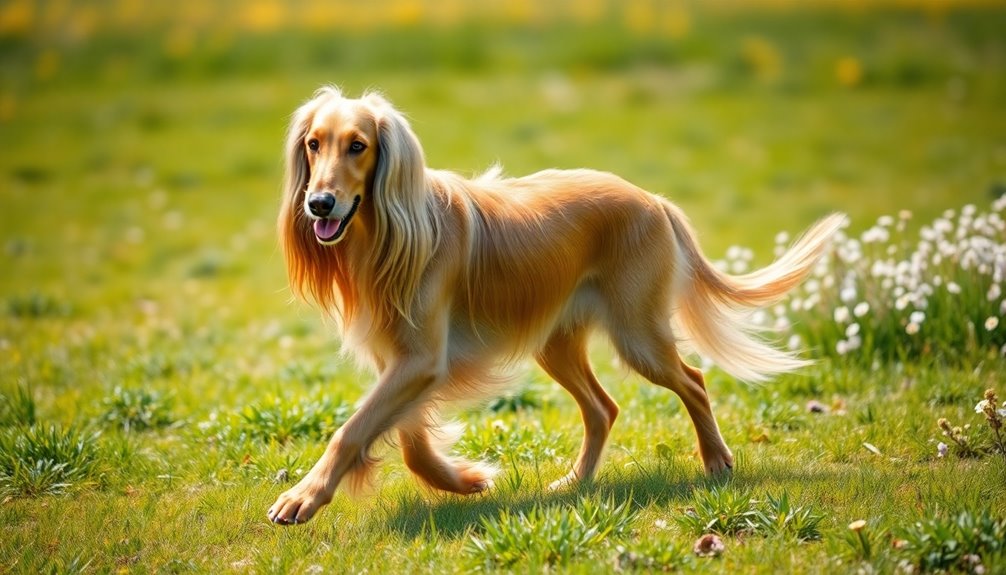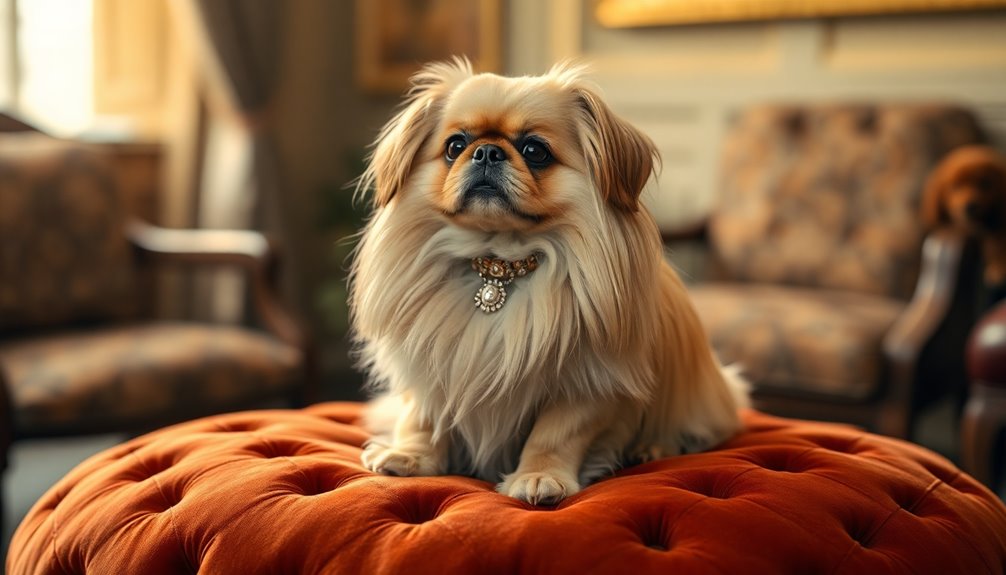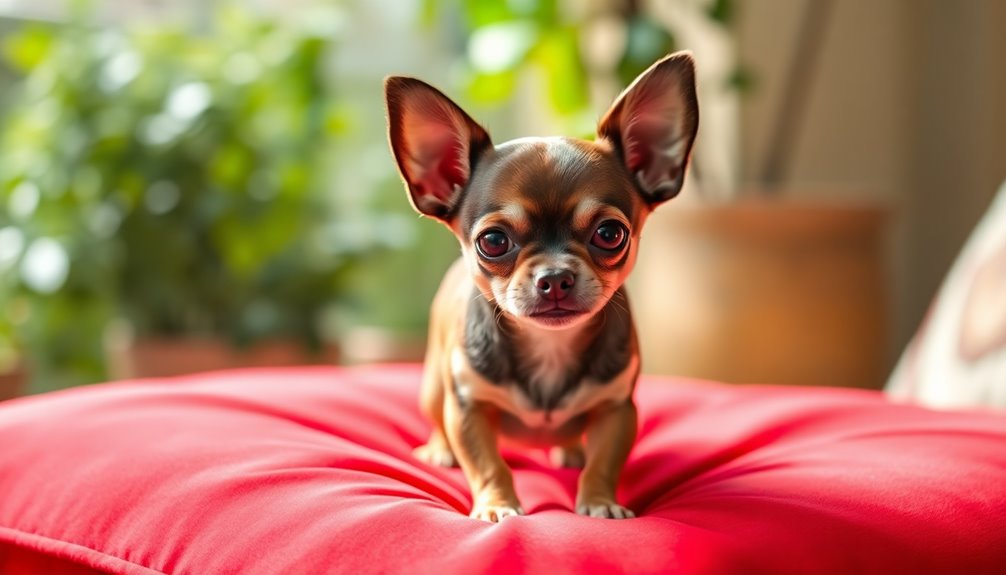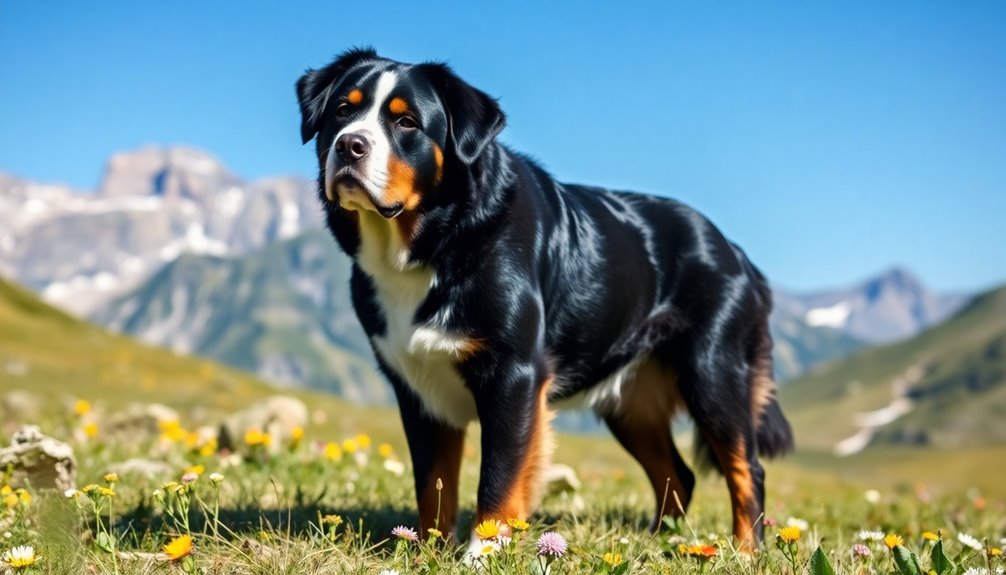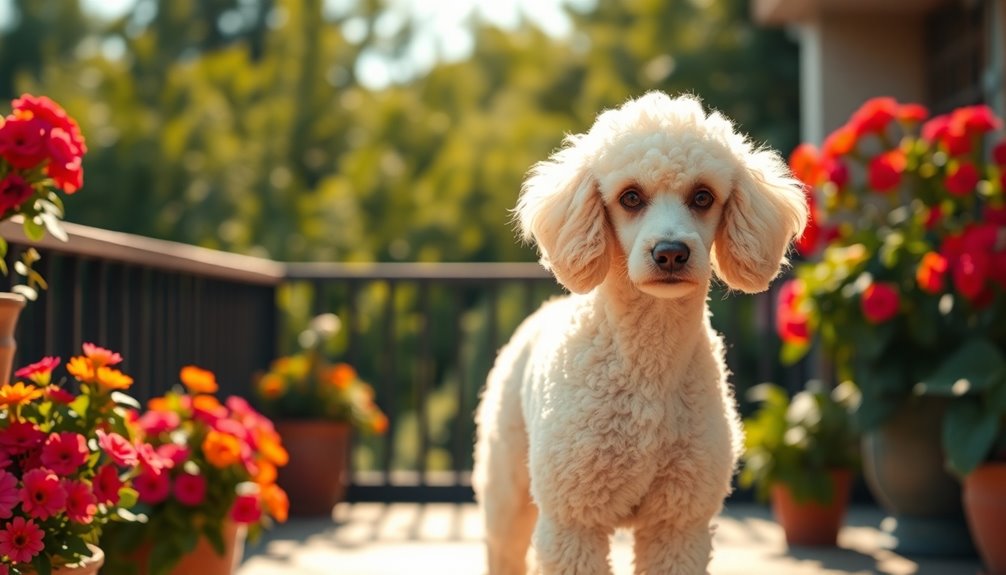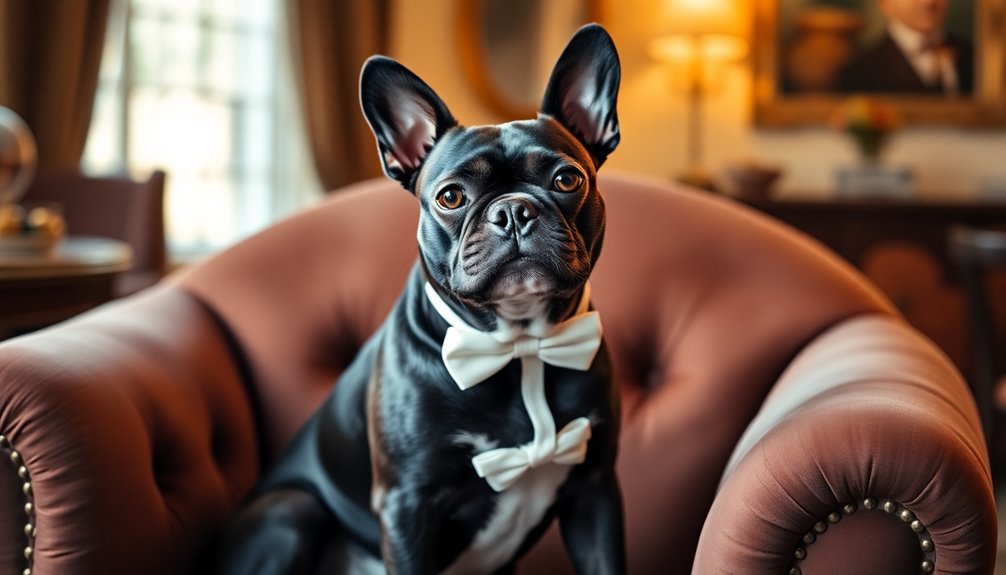The Afghan Hound truly embodies grace and elegance in every step it takes. With its long, silky coat and distinct body shape, this breed turns heads wherever it goes. Originating from Afghanistan, these dogs were once prized by royalty and nomads for their beauty and hunting prowess. Their gentle yet independent nature makes them great companions, especially for families. While they require regular grooming to maintain their luxurious coat, their charming personality is worth the effort. If you're curious about their history, grooming tips, and training needs, there's much more to discover about this majestic breed!
Key Takeaways
- Afghan Hounds are renowned for their regal bearing and unique appearance, characterized by a long, silky coat and elegant stature.
- Originating from Afghanistan, Afghan Hounds were bred for hunting large game, making them both athletic and graceful.
- Their grooming needs are extensive, requiring regular brushing and professional grooming to maintain their luxurious coat and prevent matting.
- Afghan Hounds thrive on daily exercise and mental stimulation, showcasing their energy and agility through activities like running and lure coursing.
- With a gentle yet independent nature, they adapt well to family life, forming strong bonds with children and other pets when properly socialized.
Introduction
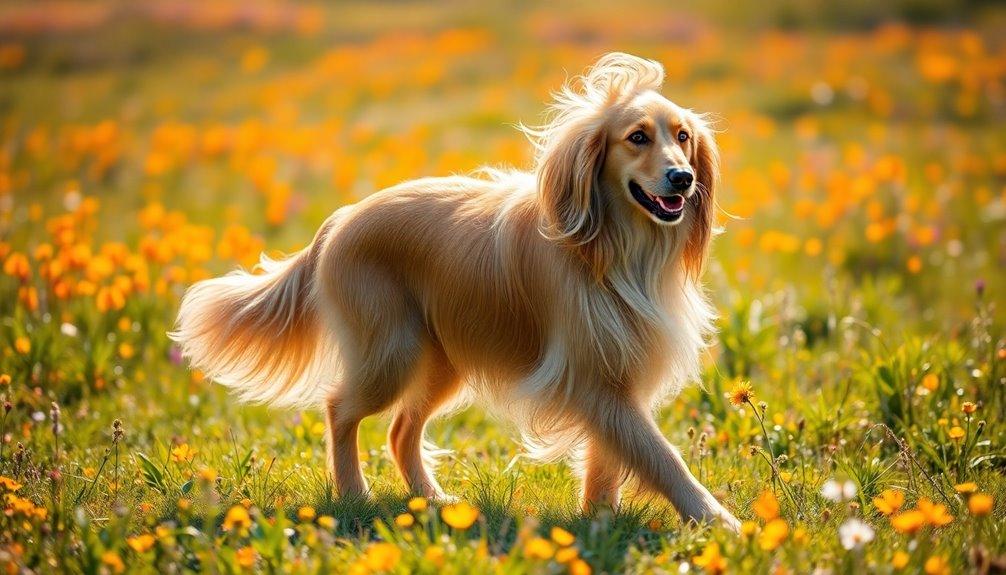
The Afghan Hound is a striking breed known for its elegance and unique appearance. Standing about 27 inches tall for males and 25 inches for females, these dogs typically weigh between 50 and 60 pounds. Their body is square-shaped, with the length of the body equaling the height, which adds to their regal bearing.
Their long, silky coat, short on the foreface and back, enhances their graceful look, while the tail, long with a ring or curve at the end, adds an extra touch of flair.
When you look at an Afghan Hound, you'll notice its dolichocephalic head shape, giving it a long, slightly aquiline appearance. The ears are long and pendant, complementing the dog's long, tapering muzzle. With powerful, deep jaws and a refined beard, they've a distinctive facial presence.
While independent and strong-willed, Afghan Hounds can be aloof with strangers but are exuberantly playful with their families. Their gentle disposition and quirky personality make them delightful companions. They were historically used for hunting in mountainous terrain, showcasing their intelligence and agility.
Though they may not bark much, their unique charm and sophistication make them stand out in any setting.
History and Origin
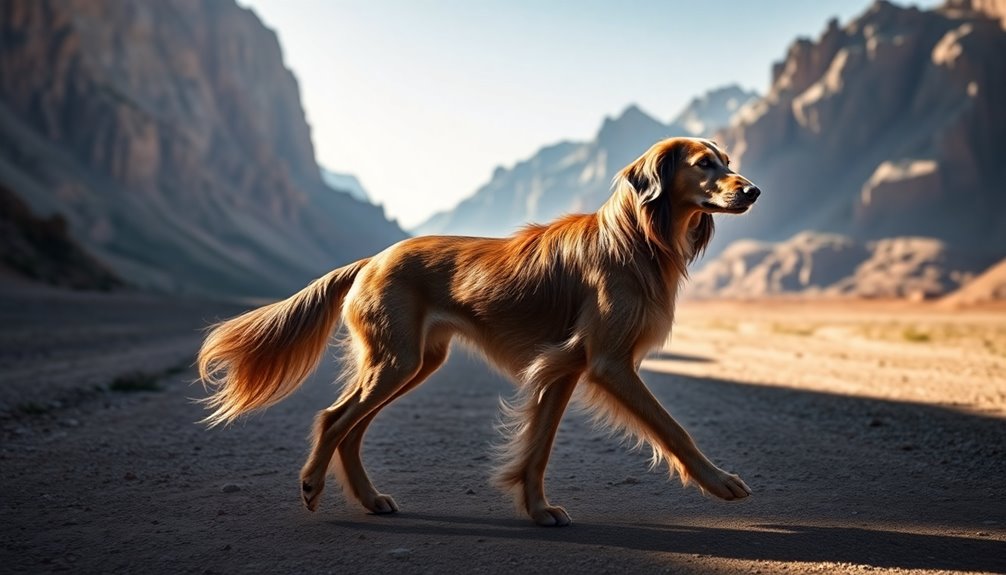
The Afghan Hound has ancient roots, tracing back to around 4,000 BC in the mountainous regions of Afghanistan. Known as Tazi in their native area, these sighthounds were originally bred for hunting large game. Their unique history reflects their significance as both hunting companions and status symbols throughout various cultures. The breed's long coat provided protection from the cold climates in which they thrived.
Where and when the breed originated
Originating in the rugged mountainous regions of Afghanistan, the Afghan Hound boasts a rich history that spans thousands of years.
Evidence of this graceful breed dates back to around 4,000 BC, with depictions found in ancient cave paintings and Egyptian papyruses. As you explore its origins, you'll discover that the Afghan Hound expanded beyond its native land, reaching areas like Persia and India, and becoming a beloved companion in the Middle East. The breed was known for its exceptional running abilities, making it a formidable hunting partner.
The breed was highly prized by nomadic tribes, royalty, and tribal leaders, serving as both hunting companions and symbols of status. Historical figures, including Alexander the Great and Genghis Khan, cherished these dogs, showcasing their significance across generations.
British soldiers introduced the breed to the West during the 19th century, bringing it to England in the early 1900s.
Sighthound for Large Game
Hunting large game has been a defining characteristic of the Afghan Hound for centuries, showcasing its remarkable talents and physical prowess. Bred specifically to hunt large animals like leopards, these dogs excelled in challenging terrains, including deserts and mountains. They were adept at holding large game at bay until hunters could arrive, demonstrating incredible courage and stamina.
With their long, silky coats and distinct physical attributes, Afghan Hounds possess features that enhance their hunting abilities. Their long heads and necks, paired with triangular dark brown eyes and pendant ears, contribute to their keen vision and agility. Capable of reaching speeds up to 40 miles per hour, they embody the sighthound category, making them formidable hunters. Additionally, Afghan Hounds require extensive exercise to maintain their high energy and stamina levels.
Even today, Afghan Hounds retain these hunting traits, although they're more commonly kept as family pets or show dogs. Regular exercise is essential to maintain their athleticism, and their strong prey drive means they require careful management.
While they form close bonds with family, they can be aloof with strangers, keeping that elegant, independent spirit alive.
Physical Characteristics
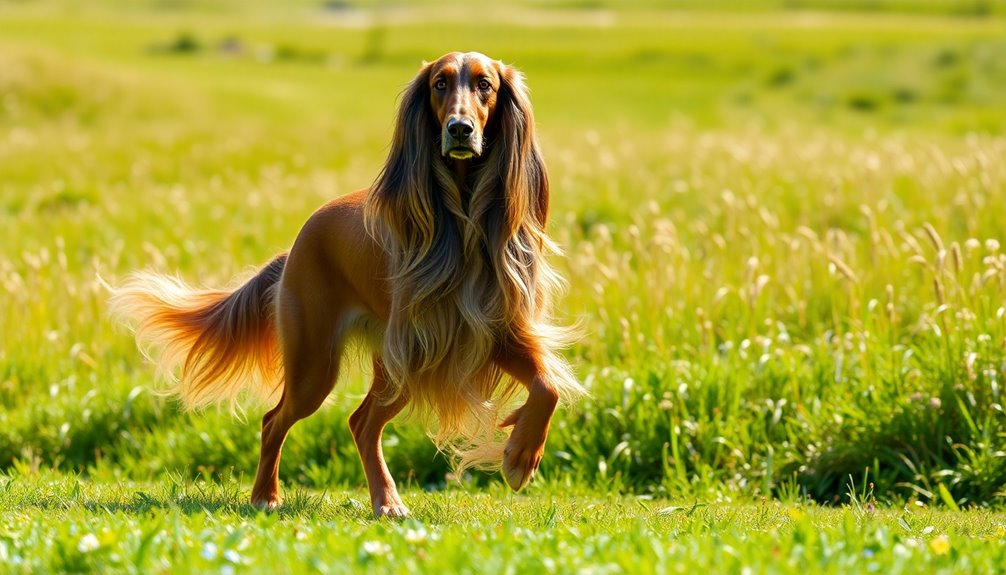
When you look at an Afghan Hound, you can't help but notice their impressive size and unique coat.
Males typically stand around 27 inches tall and weigh between 60 to 70 pounds, while females are slightly smaller.
Their long, flowing silky coat not only adds to their elegance but also requires dedicated grooming to keep it in top shape. The breed is known for its diverse color variations, which can be a striking feature in shows.
Size, weight, and coat details
The Afghan Hound boasts impressive physical characteristics, making it a striking breed. Males typically stand between 27 to 29 inches at the shoulder, while females range from 25 to 27 inches. At birth, your puppy will measure between 8 to 10 inches and reach around 25 to 27 inches by their first birthday. In fact, male Afghan Hounds can weigh up to 60-80 lbs by the age of three.
In terms of weight, adult males weigh between 60 to 70 pounds, with some reaching up to 65 pounds. Females usually weigh between 50 to 60 pounds, and at birth, puppies weigh around 2.5 to 4.5 pounds, hitting 50 to 60 pounds by age one.
This breed features slender, elongated bodies with fine musculature that isn't overly pronounced. Their long, dolichocephalic heads are complemented by almond-shaped dark eyes and long ears covered in silky hair.
The long, strong neck is arched gracefully, leading to prominent hipbones and large feet. The forelegs are straight and strong, with well-held elbows, while all four feet align with the body, displaying arched toes cloaked in thick hair.
The distinctive curled tail adds to their elegant appearance, making the Afghan Hound a true marvel of nature.
Long, Flowing Silky Coat
Few breeds can match the Afghan Hound's stunning long, flowing silky coat, which is one of its most defining features. This coat is long, fine, and reminiscent of human hair, giving it a luxurious appearance that cascades gracefully to the ground.
You'll notice the majestic mane, or "ruff," that forms around the neck and forequarters, along with the distinctive long "curtains" of hair on the ears.
To maintain this beautiful coat, regular grooming is essential. You should brush your Afghan Hound daily, or at least three times a week, and always follow brushing with a comb to catch any tangles.
Bathing every 15 days with conditioner keeps the coat from becoming dry and brittle. Professional grooming every eight weeks is also recommended to keep the coat in top condition.
The Afghan Hound's coat comes in a variety of colors, including black, silver, cream, red, and brindle, often showcasing unique patterns. Each dog's markings contribute to its individual beauty and the breed's overall elegance. By investing time in grooming, you'll ensure your Afghan Hound's coat remains as majestic as it deserves to be.
In addition to grooming, providing your Afghan Hound with daily exercise is crucial to maintaining its physical and mental health.
Temperament and Personality
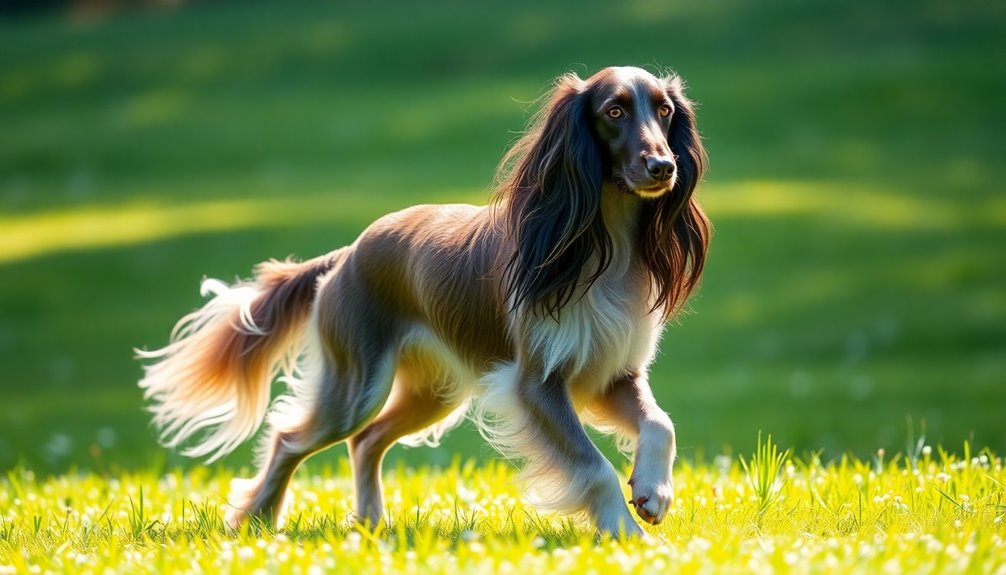
When you think about the temperament and personality of Afghan Hounds, you'll notice their gentle yet independent spirit. These dogs can fit well into families, with individuals, or alongside other pets, but they require understanding and patience. Their unique blend of loyalty and self-confidence makes them both loving companions and intriguing characters. However, they can become wary of strangers if not properly socialized from a young age.
Gentle yet Independent Spirit
Afghan Hounds embody a unique blend of gentleness and independence that sets them apart from other breeds. Known for their strong-willed nature, these dogs carry an air of self-sufficiency that can sometimes be mistaken for aloofness.
You'll find that they require patient and respectful training methods, as consistent leadership is essential to establish the boundaries they need.
Around strangers, Afghan Hounds often prefer to observe from a distance, taking their time to warm up. Proper socialization from a young age is crucial for promoting well-rounded behavior, allowing them to engage positively with new people and situations.
This socialization should continue throughout their lives to maintain their social skills.
Despite their reserved demeanor, Afghan Hounds are incredibly affectionate and loyal to their families. They form strong bonds with their loved ones and actively seek attention and affection.
Their gentle disposition shines through, especially in the company of their family members. Additionally, their independent nature often means they thrive with owners who respect their autonomy and provide them with engaging activities.
Playfulness and curiosity add to their charm, particularly during exercise and playtime. Engaging them in activities keeps them physically and mentally stimulated, allowing their playful spirit to emerge, especially when they're younger.
Suitability for families, individuals, or other pets
Many families and individuals find Afghan Hounds to be excellent companions due to their unique combination of loyalty, independence, and playful spirit. They form close bonds with family members and are particularly good with children, especially when introduced at a young age. Their playful and comical nature makes them delightful family pets. However, it's important to teach kids respectful handling of their long mane to avoid any mishaps. Engaging in active play helps promote a strong bond and ensures they receive the physical activity they need.
For individuals, Afghan Hounds thrive with owners who appreciate their independent nature. They don't demand constant attention but need both companionship and personal space. Their loyalty and affection are profound, but they require active owners who can provide sufficient exercise. Additionally, regular vet check-ups can help identify any potential health issues before they become serious. Training should be approached calmly and assertively, as they're sensitive to tone.
When it comes to other pets, Afghan Hounds can coexist with them, given careful introductions. However, due to their high prey drive, they should never be left unattended with smaller animals. While they might be indifferent to some pets, supervision is essential to ensure harmony. Overall, Afghan Hounds can fit well in various living situations with proper management and care.
Health and Lifespan
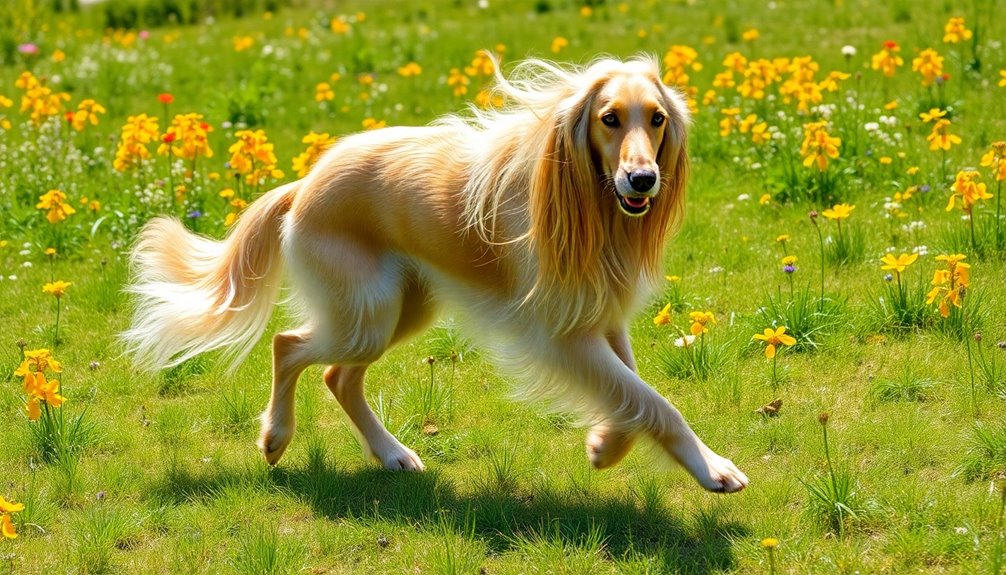
When it comes to Afghan Hounds, understanding their health and lifespan is crucial for their well-being.
These dogs typically live between 11.1 to 14 years, but they're prone to certain health concerns like hip dysplasia and allergies. Regular veterinary check-ups are recommended for early detection of health issues, ensuring that any potential problems are addressed promptly.
Typical lifespan of the breed
Understanding the typical lifespan of the Afghan Hound can help you better prepare for their long-term care. Generally, you can expect your Afghan Hound to live between 12 to 14 years, with some reaching up to 18 years in optimal conditions. A study from the UK suggests an average lifespan of 11.1 years, which is slightly lower than the common range reported by various sources. When you consider the average lifespan of purebreeds is about 12.7 years and 12 years for crossbreeds, Afghan Hounds fall in a similar range. If health issues are minimal and you provide good care, many can live comfortably into their early to mid-teens, with the average for those succumbing to old age being around 13 to 14.5 years. Several factors can influence their lifespan, including genetics, health conditions, and the level of care and maintenance you provide. Interestingly, Afghan Hounds have a low coefficient of inbreeding at 7.7%, which can be advantageous for their overall health. Additionally, the breed is known to be prone to certain health issues such as cancer and hip dysplasia, which can impact their longevity.
Common health concerns or genetic predispositions
Afghan Hounds can be prone to several health concerns and genetic predispositions that may affect their quality of life and longevity. One serious issue is Gastric Dilatation-Volvulus (GDV), which deep-chested dogs like Afghan Hounds are susceptible to. Symptoms include abdominal pain, swelling, and retching without vomiting, requiring emergency care for a positive outcome.
Musculoskeletal problems like Panosteitis and Hip Dysplasia are also common. Panosteitis causes painful inflammation in young dogs, while Hip Dysplasia leads to improper hip joint formation and arthritis, often detectable through X-rays.
Neurological disorders such as Hereditary Necrotizing Myelopathy (ENM) and Afghan Hound Myelopathy can significantly impact your dog's mobility and quality of life. Early signs of these conditions often manifest in young dogs. Additionally, Afghan Hounds are known for their sensitivity to anesthesia, which can complicate surgical procedures and requires careful planning with an experienced vet.
Additionally, Afghan Hounds are vulnerable to heart disease and conditions like Chylothorax, which can strain the heart and lungs. Regular veterinary check-ups are essential for early detection.
Eye issues, including cataracts and Progressive Retinal Atrophy (PRA), may also arise. Being aware of these potential health concerns can help you take proactive steps for your Afghan Hound's well-being.
Tips for maintaining health and wellness
To ensure your Afghan Hound stays healthy and lives a long, vibrant life, focus on three key areas: nutrition, exercise, and regular veterinary care.
Start with nutrition by choosing high-quality dog food designed for medium to large breeds. Control portions to prevent obesity, and maintain a consistent feeding schedule with two to three meals daily. Always provide fresh, clean water to keep your hound hydrated. Treats can be a great reward but use them in moderation. Afghan Hounds have a silken coat that requires regular grooming to maintain its beauty and prevent tangles.
Exercise is vital; aim for at least 30 minutes of brisk walks every day. Allow your Afghan Hound supervised off-leash time to run and play, and mix in activities like agility and lure coursing for variety. Keep their mind sharp with puzzle toys and training sessions.
Finally, schedule regular veterinary check-ups at least twice a year. Monitor their weight closely to avoid joint stress and health issues. Keep vaccinations current and adjust their water intake based on activity and weather.
With these tips, you'll help your Afghan Hound thrive and enjoy a happy, healthy life.
Care Requirements
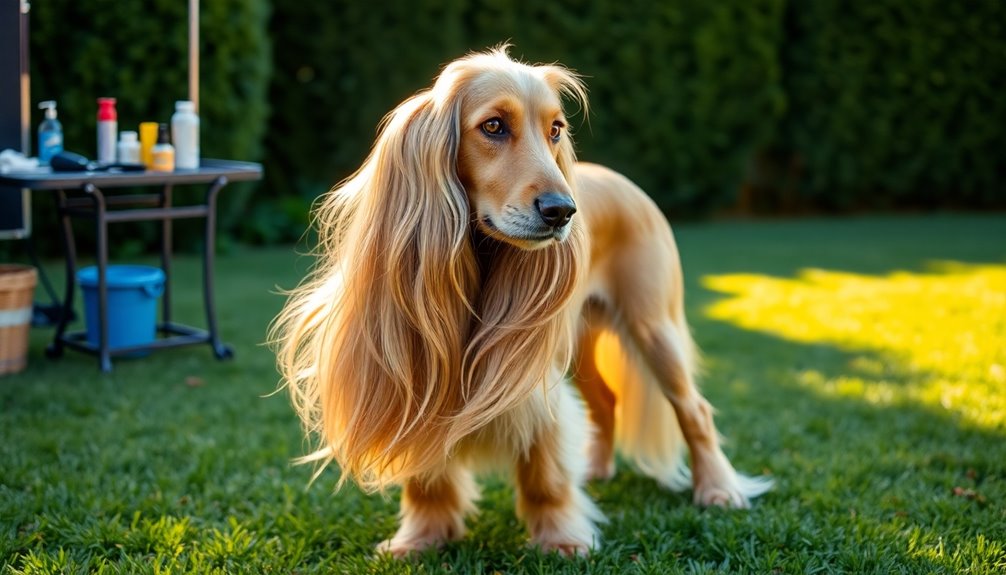
Caring for your Afghan Hound involves regular grooming, daily exercise, and a balanced diet tailored to their needs. You need to brush their luxurious coat at least once a week and make sure they get plenty of physical activity to stay healthy and happy. Additionally, focusing on their nutrition will help keep them in great shape while preventing obesity. Providing a calm home environment is also crucial for their emotional well-being, as it fosters a sense of security and stability. Regular exercise is essential, as it not only helps maintain a healthy weight but also reduces the risk of obesity in pets.
Weekly Brushing Required
For anyone looking to maintain the beauty of an Afghan Hound, weekly brushing is crucial. Ideally, you should brush your hound daily to prevent knotting, but a minimum of three times a week will keep the coat tangle-free.
Start brushing from the lower rear legs and work your way upwards. Use a slicker brush, gently pulling the coat out and away from the skin as you go. Following this, use a comb to check for any missed tangles.
Utilizing the right tools is key. In addition to a slicker brush, have a pin brush and a Greyhound comb handy. A conditioning spray can provide shine, hydration, and help prevent breakage. For knots, a detangling brush is essential.
Make sure you work evenly across your dog's body, holding or pushing up the coat with one hand for better access. Pay extra attention to areas like the legs, collar, ears, and tail. Regular grooming not only enhances your Afghan Hound's appearance but also contributes to their overall health and well-being, as maintaining a mat- and tangle-free coat is essential for their comfort and aesthetics.
After brushing, inspect the coat for remaining knots and ensure it's light and airy. Regular grooming not only enhances your Afghan Hound's appearance but also contributes to their overall health and well-being.
Exercise requirements and energy levels
Afghan Hounds require a substantial amount of exercise to stay healthy and happy, needing about two hours daily. This high-energy breed thrives on a mix of activities, including walks, runs, and engaging their natural hunting instincts through lure coursing.
It's essential to provide off-leash time in securely enclosed areas, as they can easily run off if given the chance. While they generally calm down indoors, they become lively and playful outdoors, making regular physical activity vital. If you live in a smaller space, they can adapt, but without sufficient exercise, they might become destructive.
To keep them mentally stimulated, incorporate puzzle toys, training sessions, and interactive games into their routine. Engaging their intelligence prevents boredom, which can lead to unwanted behaviors.
Early socialization is also crucial, helping your Afghan Hound develop well-rounded behavior. Their hypoallergenic nature allows them to be suitable for allergy sufferers, making them a great choice for families with sensitivities. Always supervise their exercise to ensure safety, especially given their strong prey drive.
Feeding tips and diet recommendations
Nutrition plays a crucial role in keeping your Afghan Hound healthy and vibrant. Start by choosing high-quality dog food that meets AAFCO nutritional standards and is appropriate for your dog's life stage—puppy, adult, or senior. Brands like Purina®, Hill's®, or Royal Canin® offer balanced and complete diets, eliminating the need for additional supplements. Follow the feeding guidelines to ensure proper portions.
For mature Afghan Hounds, feed them twice a day to help prevent bloat. Puppies may need three to four meals until they're around 18 months old. Be mindful of portion control; adjust based on age, activity level, and health to prevent obesity. Monitor their weight regularly to keep them slim and healthy. Additionally, a balanced diet is essential for maintaining their overall health and preventing breed-specific issues. Including healthy fats in their diet is also important for skin and coat health.
Include a mix of proteins, carbohydrates, and fats in their diet. Use sources like beef, chicken, and fish for protein, while vegetables and fruits provide necessary carbohydrates. Incorporate healthy fats, focusing on Omega-3 and Omega-6 fatty acids.
Consider slow-feeder bowls to encourage slower eating and reduce the risk of bloat. If you're adding treats or supplements, do so gradually and consult your vet for guidance.
Training and Socialization
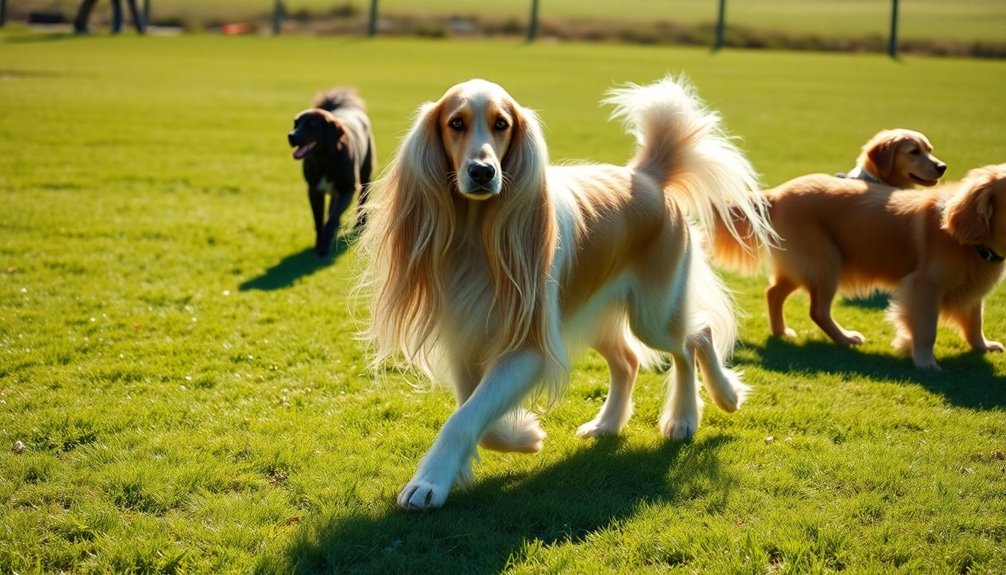
Training your Afghan Hound can be a challenge due to their stubbornness and independent nature. It's important to gradually expose them to diverse environments to help with socialization and reduce leash pulling during walks. Incorporating early socialization into their training routine can significantly enhance their adaptability to various situations.
Stubborn With Independent Streak
When it comes to training Afghan Hounds, you'll quickly discover their independent streak can make the process challenging. Bred to hunt solo, these dogs often prefer to do things their way, which can lead to stubbornness during training sessions.
To effectively teach them, you'll need to embrace creative methods that resonate with their unique perspective. Harsh corrections? They won't work and might cause your hound to shut down.
Instead, focus on positive reinforcement techniques, using treats and praise to motivate your Afghan Hound. This approach not only encourages desired behaviors but also builds trust and compliance. Given their strong prey drive, it's essential to keep training sessions engaging to prevent distractions during learning. Additionally, understanding their behavioral challenges can help tailor training methods that work best for them.
Remember, confident and consistent leadership is crucial for success. Patience is key; rushing through training can lead to resistance. Establishing clear boundaries through consistent training helps your hound understand what you expect.
Always approach training with respect, acknowledging their independent nature. With dedication and a gentle touch, you'll find that your Afghan Hound can be a willing participant in the learning process.
Embrace the journey, and soon enough, you'll appreciate the grace and intelligence that this majestic breed has to offer.
Gradual Exposure to Diverse Environments
Exposing your Afghan Hound to a variety of environments is essential for their development into a well-adjusted adult. Start early, ideally between 3 to 14 weeks, but remember it's never too late to begin. Introduce them to different people, animals, and settings to build their confidence. Positive experiences are crucial; reward calm behavior with treats, praise, or toys to reinforce good reactions.
Take your Afghan Hound on regular walks through diverse neighborhoods and parks. This exposure to various sounds, sights, and smells will enrich their experiences. Make sure they walk on different surfaces like grass, gravel, and asphalt, helping them adapt to changing conditions. This exposure is important for developing adaptability to changes in their environment. Additionally, engaging in puppy training classes can provide a supportive atmosphere for learning and socialization.
Enrolling in puppy classes provides structured socialization with other dogs and people. Invite friends over to help your hound get comfortable with strangers in a familiar space. Trips to new locations, like city streets or nature trails, will broaden their horizons.
Finally, mix in activities that stimulate their minds, like puzzle toys or agility training. By gradually exposing your Afghan Hound to diverse environments, you're setting them up for a happy, confident life.
Leash Pulling During Walks
Leash pulling can be a frustrating issue during walks, but with the right approach, you can teach your Afghan Hound to walk calmly by your side.
Start by using a sturdy leash, 4 to 5 feet in length, with an easy-to-grip handle. Avoid retractable leashes, as they can encourage bad habits. Ensure your dog is comfortable wearing a collar or harness before you begin training.
Choose a quiet area with minimal distractions for your training. Use the lure-and-reward method with treats to encourage your dog to stay by your side. Incorporate random halts and changes in pace to keep your dog engaged. Utilizing a harness can also discourage pulling and enhance control during walks.
If they pull on the leash, immediately stop walking. Wait for your Afghan Hound to return to your side before continuing. You can also try the "change direction" technique to redirect their focus.
Be consistent in your approach, using positive reinforcement for calm walking. As your dog improves, introduce distractions gradually. You can teach the heel command as an advanced technique to regain their attention in busier environments.
Remember to reward intermittently and keep treats small to maintain motivation without overfeeding.
Ideal Living Environment
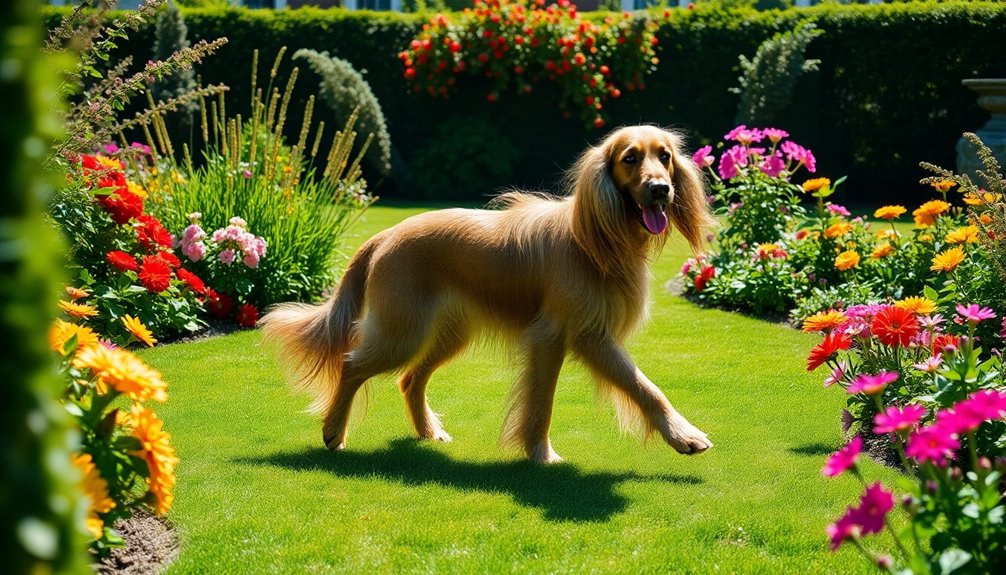
To keep your Afghan Hound happy and healthy, you'll want a spacious home with a secure yard for them to roam. They thrive in cooler, dry climates, which helps maintain their long coat and overall well-being. Providing these conditions ensures your hound gets the exercise and environment they need to flourish. Additionally, regular veterinary check-ups are important for monitoring their health and ensuring they remain active and vibrant throughout their life.
Spacious Home With Secure Yard
Creating an ideal living environment for an Afghan Hound means providing a spacious home with a secure yard that meets their unique needs.
These dogs aren't suited for apartment living, as they require ample space to move and run freely. Ideally, you should have a home with acreage, allowing your hound to stretch their legs and enjoy their natural grace.
Your yard needs to be large and securely fenced, preventing your Afghan from escaping due to their strong prey drive. A high fence will protect them from external dangers and other animals, ensuring safe playtime.
Make sure the yard is free from hazards, allowing your hound to roam and explore without worry. Additionally, having a structured routine will help your Afghan feel more secure in their environment.
Inside, you'll want to offer ample indoor space for relaxation, where your Afghan can unwind after energetic play.
Afghan Hounds thrive in households with multiple family members, especially when they're socialized early with children and other pets. While they prefer the company of adults, they appreciate being part of family activities.
Daily exercise, such as walks or runs, is essential to keep them healthy and happy, ideally in a securely fenced area where they can run free.
Prefers Cooler, Dry Climates
Afghan Hounds thrive in cooler, dry climates, reflecting their origins in the deserts and mountains of Afghanistan, India, and Pakistan. While their flowing coats might suggest they can withstand extreme cold, their thin undercoat isn't ideal for prolonged exposure to freezing temperatures. These dogs are well-adapted to hot weather, yet they prefer moderate climates where they can enjoy the warmth without overheating. You'll find that Afghan Hounds are comfortable in various temperatures, but they truly excel in dry, cooler conditions. Their physical attributes help regulate temperature, allowing them to tolerate both hot days and cool nights. Additionally, their long, silky coat requires regular grooming to prevent matting and maintain its luster, especially in fluctuating climates. However, it's crucial to provide protection during extreme weather, whether that means shade and hydration in the heat or avoiding icy surfaces in winter. When living with an Afghan Hound, regular grooming is essential to maintain their luxurious coat, especially in fluctuating climates. Always monitor for signs of discomfort and adjust their diet to meet energy needs based on the weather. With the right care, your Afghan Hound will thrive, showcasing its grace in the ideal living environment.
Unique Grooming Needs
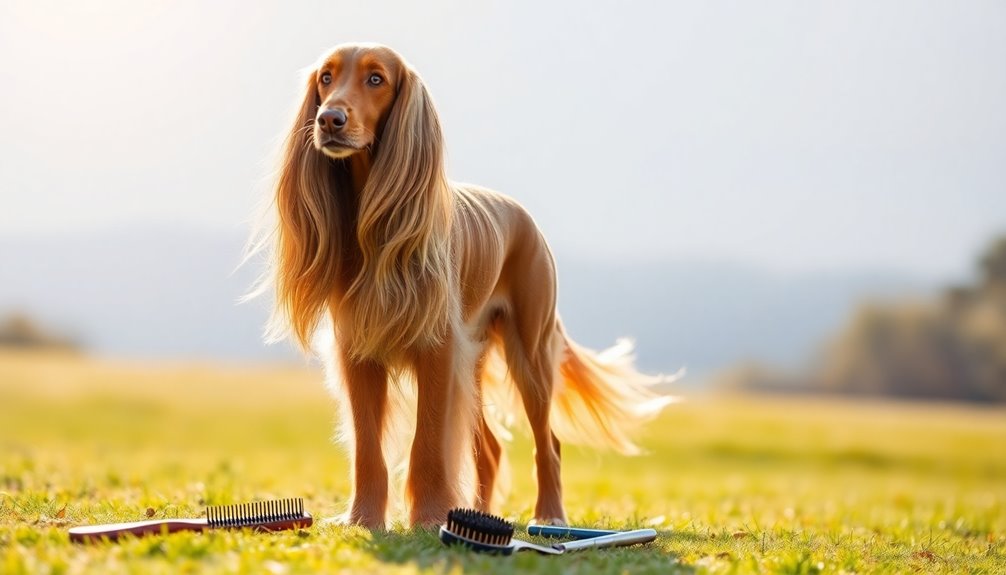
When you own an Afghan Hound, you're caring for a breed that once graced the courts of royalty and now struts down Hollywood runways. Their luxurious coat requires meticulous grooming to maintain that iconic look, making it essential for you to stay on top of their needs. From daily brushing to regular baths, embracing their unique grooming routine sets you up for success with this elegant breed. Establishing consistent grooming habits during puppyhood will prevent future matting and grooming issues.
Ancient Breed Used for Royalty
The Afghan Hound's regal history is matched only by its unique grooming needs, which can be quite a challenge for owners. This ancient breed, once prized by royalty and nomadic tribes, boasts a long, flowing coat that requires diligent care to maintain its beauty and health. Interaction with animals through pet therapy can enhance emotional well-being, making it a valuable experience for both pets and their owners.
You'll need to commit to daily grooming to prevent matting and tangling, especially in areas like behind the ears and mid-thighs. Regular brushing isn't just a luxury; it's essential to keep your Afghan looking dignified and elegant.
Baths should happen every 4 to 5 days, particularly in inclement weather, to ensure the coat remains clean and manageable. To effectively groom your hound, you'll want to invest in a standing hair dryer, oval pin brush, and slicker brush.
Be proactive in grooming—bathe and brush your Afghan before matting occurs. This breed's unique grooming routine reflects its royal heritage, and with consistent care, you can maintain its majestic appearance.
Embrace the commitment; your Afghan Hound will reward you with the grace and beauty befitting its noble status.
Hollywood's Iconic Fashion Model
How does an Afghan Hound maintain its status as Hollywood's iconic fashion model? It starts with daily brushing to keep that luxurious coat in top shape. You'll want to use a pin brush, working through the hair in sections to avoid mats and tangles. Always brush from the bottom up to protect the skin. This routine not only keeps their coat silky but also creates a great bonding experience. Additionally, establishing a reputation for excellence in branding can significantly enhance an Afghan Hound's visibility in the entertainment industry.
Bathing every one to two weeks is essential for a clean, shiny look. Choose high-quality shampoo and conditioner to preserve those natural oils, and make sure to rinse thoroughly to prevent irritation. After bathing, proper drying is key—use a blow dryer on a low heat setting while brushing to avoid frizziness.
While at-home grooming is crucial, don't underestimate the value of professional groomers. They understand the breed's unique needs and can check for potential health issues, like skin irritations or ear infections.
Regular nail trimming and dental care are also important. Keeping your Afghan Hound well-groomed not only showcases its beauty but also contributes to its overall health and well-being.
Affectionate With Family Members
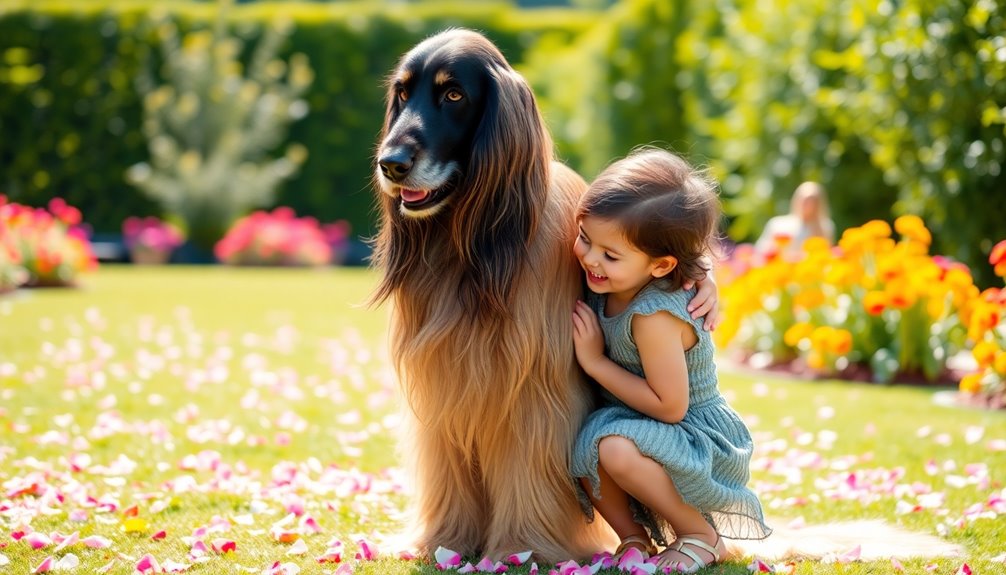
Afghan Hounds are incredibly affectionate with their family members, forming deep bonds that thrive on attention and interaction. Additionally, their unique physical features and evolutionary history contribute to their captivating presence, making them even more endearing. They require experienced handlers who can provide the grooming and care these elegant dogs need while also engaging them in daily activities. If you establish a strong connection, you'll find them to be loyal and loving companions who seek your affection in their own gentle way.
Ideal for Experienced Handlers
Understanding their affectionate nature, you'll find that Afghan Hounds form strong bonds with their families and are loyal companions. Their devotion makes them wonderful pets for those who can appreciate their unique temperament. Regular dental visits are important for maintaining overall health, which is crucial for your canine friends as well.
While they thrive on attention and affection from you, they may be reserved around strangers, taking time to warm up. This independent spirit can sometimes come off as stubbornness, which means training may require extra patience and consistency.
For experienced handlers, these dogs present a rewarding challenge. They often understand commands but might choose not to follow them, so using positive reinforcement—like treats and praise—becomes essential. The Afghan Hound Club of America organizes events such as the 87th Annual National Specialty to promote the breed and enhance community engagement.
Early socialization helps them adapt better to various environments, especially around kids and other pets. Engaging in mindfulness practices can also help you bond with your Afghan Hound, enhancing your connection and understanding of their needs.
Though they prefer adult company, with the right approach, they can coexist well with children. Afghan Hounds need ample space and regular exercise, so be sure to provide a secure area for their outdoor adventures.
Their strong prey drive requires that they stay on a leash or in a fenced yard. If you're ready to embrace their affectionate yet independent nature, an Afghan Hound can become a cherished member of your family.
High Grooming Maintenance Required
Caring for an Afghan Hound goes beyond just training and socialization; it also involves a significant commitment to grooming. Their luxurious coat requires regular attention to keep it looking its best. You should brush your Afghan's coat a few times a week, but daily grooming is ideal to prevent tangles and maintain its condition.
Use a brush followed by a comb, and consider applying a conditioner in spray form to ease the process. Bathing is essential, too. Depending on your dog's needs, you'll want to give baths every 15 days to once every 12 weeks. Always check for mats and tangles before bathing and remove them if possible. Regular hygiene practices include cleaning ears with a mild solution, trimming nails every four to six weeks, and brushing teeth daily with dog-specific toothpaste. Trimming and clipping are also part of the routine. You can use stripping techniques on specific areas or hire a professional groomer every eight weeks for best results.
Additionally, using a moisturizing shampoo during bathing is crucial to ensure hydration and coat shine. Daily checks are crucial, especially in spots prone to matting, ensuring your Afghan Hound remains a stunning companion with a coat that reflects its majestic nature.
Frequently Asked Questions
Are Afghan Hounds Good With Children?
Afghan Hounds can be good with children, especially older kids, if you socialize them properly. They often enjoy the company of children when taught how to interact respectfully.
However, you should supervise their interactions, particularly with younger kids, due to the dog's independent nature and strong prey drive.
Regular training and positive reinforcement are essential to ensure a harmonious environment.
With patience and consistency, Afghan Hounds can become loving family companions.
How Much Exercise Do Afghan Hounds Need Daily?
Afghan Hounds need about 2 hours of exercise daily. You should mix walks, runs, and other activities to keep them engaged.
Spread the exercise throughout the day to match their high energy levels. Incorporate activities that tap into their hunting instincts, like lure coursing or swimming.
Always exercise them in safe, enclosed areas to prevent them from running off. Regular activity is crucial for their mental and physical wellbeing, so keep it varied and fun!
What Is the Average Lifespan of an Afghan Hound?
The average lifespan of an Afghan Hound typically ranges from 12 to 15 years, with some living up to 18 years under optimal care.
Factors like proper nutrition and health management play a crucial role in extending their lives.
However, be aware that they're prone to certain health issues, including cancer and dysplasia, which can impact longevity.
Regular vet check-ups are essential to help monitor and address any potential health concerns.
Do Afghan Hounds Shed a Lot?
Afghan Hounds are moderate shedders, so you might notice some hair around your home. Shedding can increase during seasonal changes, making regular grooming essential to manage it.
To keep your living space tidy, brush your Afghan Hound two or three times a week and pay special attention to areas prone to matting. With consistent care, you can enjoy the beauty of their luxurious coat without excessive shedding in your environment.
How Do Afghan Hounds Handle Cold Weather?
Afghan Hounds don't handle cold weather too well. Their silky coat provides some insulation, but it isn't dense enough for extreme cold.
You'll need to protect them with jackets or sweaters during chilly outings. Keep exercise moderate and shorten walks to prevent discomfort.
Make sure they've a warm, insulated shelter and monitor them closely for signs of cold stress. Providing extra calories in their diet during winter is also a smart move.
Conclusion
In conclusion, the Afghan Hound's elegance and charm make it a captivating companion. With their rich history and unique grooming needs, these dogs require dedicated care and attention. Their affectionate nature and playful spirit can bring joy to any household. If you're ready to embrace their regal presence and invest time in training and socialization, you'll find that an Afghan Hound can become a loyal family member, gracing your life with beauty and love.

